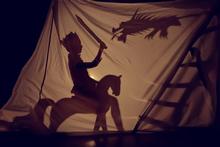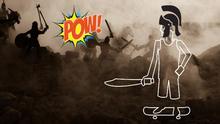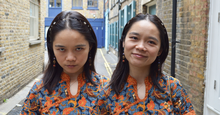What Story Are You Playing?
Archetypal Elements in World of Warcraft—Part 1
In a previous article, Archetypes and Family Dynamics, Yvonne Nelson-Reid, Ph.D., discussed how the archetypes the three men in her family had as Allies in their PMAI® profiles were represented in the roles they took on when they played the game World of Warcraft (WoW) together. In this article, Storywell staff member and longtime WoW player, Logan Abbitt, gives us insight into how the PMAI archetypes can be represented in the realm of WoW.
(Note: WoW is an online, high fantasy role-playing game. Players create a character to be within the game. Every character has a race and a class. Race in this context is a character’s ancestry (Human, Elf, Gnome, Orc, Tauren, etc.), and class is the character’s profession (Warrior, Mage, Priest, etc.). There are three primary roles, or jobs, for a character to fulfill: the tank draws enemy fire to himself and away from others, the damage dealer inflicts harm on the enemy, and the healer mends any damage done by an enemy. In this article, elements from WoW are in italics and the PMAI archetypes are bold.)
Online, high fantasy games such as World of Warcraft are archetypal in nature; they are symbolic and imaginative, and the world and characters within WoW have timeless, mythic qualities. We are transported to another realm with familiar rules and laws, but also some magic and a good dose of the irrational—elements that create an enchantment often missing in our daily lives, something both WoW and archetypes can give to us. Demonstrating how the 12 PMAI archetypes are represented in the realm of WoW itself, this first article looks at 6 of the archetypes: Warrior, Caregiver, Idealist, Realist, Seeker, and Lover; stay tuned for the next article where the final 6 archetypes, and their WoW counterparts, will be revealed.
It is a little on the nose to say the Warrior class is the dominant archetypal representation in World of Warcraft, and it is accurate. According to Pearson and Marr, the Warrior archetype in the PMAI system enjoys “competing, fighting to protect yourself and others.”1 Warriors are usually leading the charge into battle, tearing across the battlefield and using furious shouts and terrifying banners to rally their allies and intimidate their enemies. In their role as tank, they are there to protect the party, drawing aggression by commanding foes, “Attack me!” There are other tank classes in the game, but Warriors are best built for it.
In sharp contrast, the Caregiver archetype is embodied by what is arguably the most important class in the game, the primary healer class, the Priest. As “helping and nurturing others is a prime value”2 for the Caregiver, the Priest is the master of healing and preservation, restoring their wounded allies, shielding them in battle and even resurrecting fallen comrades from death. The Priest makes the adventure possible. The tank, and indeed the entire party, cannot do their job without a good healer. Other classes heal, too, but not with the raw power of the Priest.
The Idealist archetype “remains positive and optimistic even when dealing with daunting situations, endeavoring to stay true to beliefs and values that they hold dear.”3 The Shaman class that endeavors to bring balance to the chaos of the primal fury of the world is a good symbol of the Idealist archetype. They see peace in the world that is hard for others to see. Shamans are spiritual guides for their tribe or clan. Idealists, in WoW and in our world, live in a reality of warriors and healers and fit in with both.
The Realist archetype prides themself on practicality, doing what works, and seeing what is likely. In a game that is inherently fantastical, this archetype is a little harder to see. We should look to a race rather than a class. With a knack for adapting to the situation, Humans are impressively versatile, and their skill set helps them with literally any role. This aligns with the Realist’s versatility and skill in troubleshooting. One of a Human’s innate abilities is called Diplomacy and they have the most class options of any race in the game. Connecting the Realist with the Human race has a nice intuitive ring to it as well, as it is the only element of WoW grounded in the reality outside of the game itself.
The Seeker archetype compels a search to find oneself. Some players, when playing the game, do not like the knowledge they find and pull back. The Warlock has no such qualms. Striking out into unknown territory, the Warlock is willing to go where others will not. Warlock magic is derived from their connection to forbidden knowledge that others cannot tolerate. As a viable solo class, they often quest on their own. The secret knowledge that comes from questing and readily exploring the unknown, that can intimidate many others, are more obvious aspects of the Seeker archetype, even if the Warlock is a bit darker than we typically understand Seeker to be. In the shadow qualities of the Seeker, Pearson and Marr refer to the Seeker’s isolated self-absorption, which speaks to the darkness of the Warlock.
The Lover archetype was the hardest one for me to see, which is ironic because I found the link in my favorite class: the Hunter. This is what is known as a pet class and it is built around the relationship with its companion, as is the Lover. The Hunter seeks out a beast they are truly interested in and tames it, forming a bond with it. They feed it, heal it, train it, all in an effort to build its happiness and loyalty. Failure to do so could make it leave (these mechanics were very important in the early game of WoW, but they are mostly gone now). There was a time when a Hunter would have the same companion for their entire career. With their loyal pet, the Hunter is the best solo class in the game. (The Warlock is also a pet class, but they enslave a demon, which is entirely disposable. The relationship is very different.)
The article next month will look at the next 6 PMAI archetypes: Revolutionary, Creator, Ruler, Jester, Magician, and Sage. These two articles present an analysis of how the 12 PMAI archetypes can be linked to character classes and races in WoW—hopefully this provides players with insight into their preferred archetypal roles, in the game and maybe in life, too. .png) But much like the players themselves, the possible stories presented in World of Warcraft are many. Not only are the archetypes present in obvious ways like race and class, but there are different roles to play and activities to take part in. One can engage in questing, of course, but there are also fierce battles to be won against enemy factions. A player can spend the entire game crafting or engaging in commerce. There are games within the game such as complete exploration, achievement hunting, or even a miniature version of Pokémon. Story patterns and archetypes emerge amongst the characters, the players, and the gameplay styles. Some players play only healers while others never play healers. There are myriad combinations to try on, and it’s not uncommon for one player to try on many hats. They often come back to a ‘main,’ a primary character that they prefer playing, which, in PMAI terms, may be pointing to an archetypal Ally.
But much like the players themselves, the possible stories presented in World of Warcraft are many. Not only are the archetypes present in obvious ways like race and class, but there are different roles to play and activities to take part in. One can engage in questing, of course, but there are also fierce battles to be won against enemy factions. A player can spend the entire game crafting or engaging in commerce. There are games within the game such as complete exploration, achievement hunting, or even a miniature version of Pokémon. Story patterns and archetypes emerge amongst the characters, the players, and the gameplay styles. Some players play only healers while others never play healers. There are myriad combinations to try on, and it’s not uncommon for one player to try on many hats. They often come back to a ‘main,’ a primary character that they prefer playing, which, in PMAI terms, may be pointing to an archetypal Ally.
The question is: what archetypal story are you playing?
1-3.PMAI® archetype descriptions. Storywell. (n.d.). Retrieved March 29, 2023, fromhttps://www.storywell.com//archetypes/archetype-descriptions.htm




.png)









_thumb.png)











_thumb.png)
_thumb.png)
_thumb.png)



